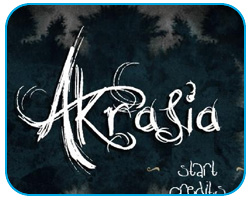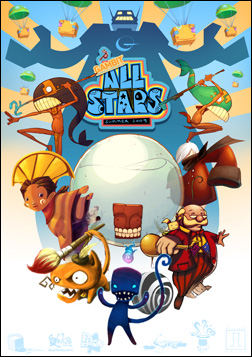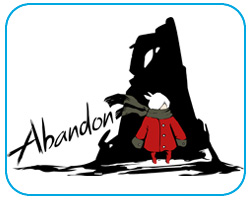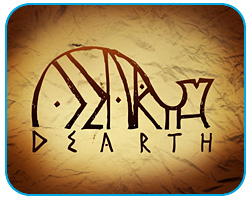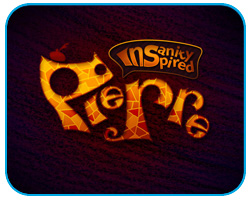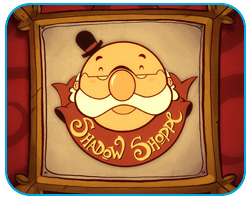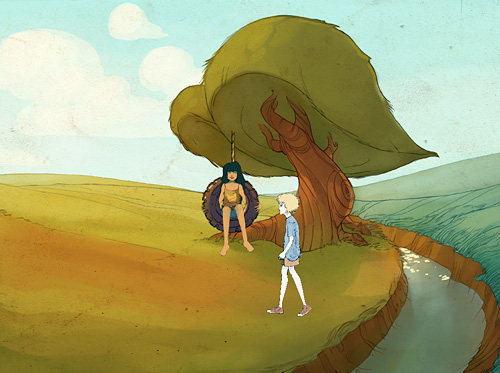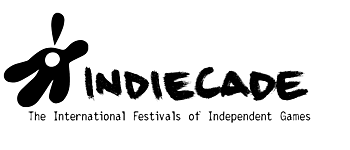
Recently in News Category
September 16, 2009
Akrasia selected for IndieCade 2009!
Akrasia, GAMBIT's arthouse prototype game from the summer of 2008, has been selected to be showcased at IndieCade 2009: The International Festival of Independent Games!
Here's the official IndieCade mission, courtesy of indiecade.org:
IndieCade supports independent game development and organizes a series of international events showcasing the future of independent games. It encourages, publicizes, and cultivates innovation and artistry in interactive media, helping to create a public perception of games as rich, diverse, artistic, and culturally significant. IndieCade's events and related production and publication programs are designed to bring visibility to and facilitate the production of new works within the emerging independent game movement. Like the independent videogame developer community itself, IndieCade's focus is global and includes producers in Asia, Latin America, Europe, Australia, and anywhere else independent games are made and played.
Akrasia is, of course, described on its official home on the GAMBIT site as follows:
Akrasia is a single-player game that challenges game conventions and is intended to make the player think and reflect. It is based on the abstract concept of addiction, which is expressed metaphorically throughout the game.
Spoiler Warning! The game is set in a maze that represents the mind. The maze has two states – a normal and a psychedelic state. To enter the game, the player has to collect a pill-shaped object and thus enters the game as "addict". From "chasing the dragon" and the experience of dependency to working your way through "cold turkey stage" where willpower is mapped onto navigation skills, this game models the essential dimensions of the addiction gestalt as identified by its creators.
Depending on player behavior and choice, the game can have various outcomes that reflect this behavior. Someone who tries to shake the habit as quickly as possible will find herself in a different situation at the end of the game than someone who indulged in chasing the high. Unlike many other games where the player is forced to learn a specific behavior in order to win the game, this game gives the player a lot of freedom in regard to the realization of the game as text. The interpretation of the game is different depending on how the game is played, thus Akrasia is a prime example of a dynamic, player-dependent meaning generation.
The game is meant to be played several times until all the connections between its various elements – the high-score, the life bar with its symbols, the two creatures that inhabit the maze in its two states, etc. – are decoded and its underlying meaning reveals itself. But although every single element in the game supports one specific reading, the beauty of Akrasia is its interpretative richness. All the elements in the game make sense in regard to one reading, but it is not the only possible one. The experiences that shall be conveyed in every single stage of the game do not only fit one experiential gestalt, but a variety of structurally similar experiences.
Akrasia takes the notion of "meaningful games" to the next level. Play it, experience it and put on your thinking cap.
IndieCade 2009 will be going down October 1-4, 2009 in Culver City, California. There's all kinds of fantastic programming planned, including the Hand-On Exhibition, a three-day Conference (including GAMBIT co-PI Henry Jenkins and friend-of-the-lab Brenda Brathwaite), an Awards Ceremony, an extensive amount of Outdoor and Pervasive Gameplay, a series of Artist Talks, and, of course, the IndieCade Happening!
Congratulations to Doris C. Rusch (Product Owner), Paul Yang (Scrummaster), Alexander Luke Chong (QA Lead), Louis Teo (Designer), Shawn Dominic Loh (Artist), Zou Xinru (Artist), Law Kok Chung (Programmer), Stephie Wu (Programmer), Erik Sahlström (Audio Designer), Jeremy Flores (Additional Audio), Pradashini Subramaniam (Additional Audio), and Guo Yuan (Additional Audio). Way to go, team!
Several GAMBITeers will be in attendance at IndieCade 2009, including Akrasia product owner Dr. Doris C. Rusch. We hope to see you there!

September 8, 2009
An Interview with Mia Consalvo
I recently had the pleasure of sitting down with Dr. Mia Consalvo, who is rejoining the GAMBIT US lab as a visiting associate professor this year, for an hour and chatting about her research interests. The resulting transcript has been published in the Fall 2009 issue of In Medias Res, the Comparative Media Studies newsletter.
Here are the first few paragraphs as a preview:
Geoffrey Long: First of all, welcome! Where are you coming from?
Mia Consalvo: I'm coming from Davis Square, but I most recently come from Ohio University's School of Media Arts and Studies. I'm an associate professor there, and I teach classes in new media, media criticism and analysis, and videogame studies. I wrote a book with MIT Press in 2007 about cheating in videogames, and right now I have two big projects going. One is on the role of Japan in the formation of the game industry and its status now, and the other relates to casual games and casual game players and casual game player culture and those kinds of things.
GL: What stage are you in with these projects?
MC: I've written a few smaller pieces that have been articles or chapters for other things that are eventually going to be collected into a book. One of the pieces, which I wrote when I was here at MIT last summer as a visiting scholar, was on the business aspect of Japanese videogame industries and how they're trying to push more for globalization.
Interestingly, even though Nintendo kind of resurrected the videogame industry in the 1980s after it went bust, and most Western kids grew up playing Nintendo, once Western companies got back up and going there was a decline in sales of Japanese games, so that now Japanese games aren't quite as dominant in the West. In Japan, it's still almost completely Japanese games on the top sellers list, but in North America and Europe it's much more split, and you see Japanese companies trying to figure out how to get that global dominance back. They have plans for different kinds of localization, transnational products, those kinds of things.
GL: When you're talking about the East and the West, you're not talking about just Japan and the United States. What is the game sale breakdown like in the rest of the world?
MC: There are three major game markets that companies look at: North America, Europe (and mostly that's Western Europe) and Japan. Korea has its own special thing with online games, but otherwise they're kind of too small. North American bestseller lists are clearly mixed as to what games are made where, and Europe is the same. There are few local European products that wouldn't sell somewhere else, like football games, and the Germans prefer PC games over console games, particularly strategy games.
In Japan, there's been this dominance of Japanese companies. When I was there in 2005 for a few months, it took me a while to realize, looking at the bestseller lists, "Wait a minute, there are no Western games here!" There were a few, like Halo and The Sims, but it was almost completely dominated by Japanese game developers. Now, because of the downturn in the economy and the declining birth rate in Japan, they've seen some declines in their sales, and Japanese companies are more motivated to look globally for other markets.
The complete article can be read online on the CMS site. Alternatively, the full Fall 2009 issue of In Medias Res can be downloaded as a 1.4 MB PDF for on-screen reading or as a 42 MB PDF for high-quality printing. Check it out! 
August 27, 2009
Announcing our Summer 2009 games!
After several long, glorious months of chaos, code and camaraderie, GAMBIT is proud to unveil our Summer 2009 GAMBIT Prototypes! This year we've highlighted the research questions for each of our games so our players get a greater idea of the thinking behind each project – and there's some genuinely amazing research in these games. For example:
- Abandon uses some new automated rigging software to fill the screen with animated objects
- Camaquen explores new interfaces for affecting character conversation in games
- Dearth examines how to create AI-controlled sidekicks automatically
- Pierre: Insanity Inspired looks at how players deal with failure
- Shadow Shoppe examines the character attributes we assign to people based on only their silhouettes
- Waker and Woosh are two educational games sharing the same mechanics but offering different experiences – story versus abstract – to examine how these experiences affect student engagement
Here's the rundown of all the summer 2009 GAMBIT prototypes!
Abandon
Abandon is a game about running away. Step into the shoes of a girl lost in a surreal dreamscape, and escape from the encroaching darkness before it consumes everything, including you. Objects strewn about this dream world are brought to life by your light, but they seek only to bring darkness. No place is safe. Can you abandon these objects; can you abandon the night? Or are you the one who has been abandoned and left… alone?
Abandon showcases a large array of animated objects. The development team utilized experimental, automated rigging software to enable rapid creation of animated models. The direction for the project was motivated by the desire to create a game featuring a large number of unique animated models, not normally feasible with a small team size and short development time frame. The team strived to create a world for the player where just about anything can come to life.
Camaquen
Camaquen is a casual puzzler in which players guide two characters through a heated argument. As part of a research project examining user interfaces for conversation in games, Camaquen models the effect of emotions in dialogue, enabling players to affect the emotional dynamics of the conversation and thus affect the outcome of the characters’ debate – even though the script remains the same. The actions of the player interact with the personalities of the brothers to determine one of five different Fates.
Players take on the role of Alux (Ah-loosh), the guardian spirit of the Sacred Grove. When the Great King dies and his kingdom is split between his sons Ban Amaru (Bahn A-mah-roo) and Huamanapu (Wah-nam-a-pu), the brothers begin to bicker over what to do with the Grove. Using Alux’s ability to command spirits of emotional energy (or "camaquen"), players change the meaning behind their words and sway the two kings to their destiny.
Does Huamanapu build his enormous stargazing tower, or does Ban Amaru move forward with his plans for a golden palace? And what happens to Alux when her Grove is transformed?
Dearth
Dearth is an exciting co-operative action-puzzler. The Tribal Lands have been suffering through the worst drought in many lifetimes. Plant life is withering away, and people fear the approach of a great famine. Rumors spread of the awakening of monstrous creatures who the ancestors warned would one day rise to drain the land and its people of their water. As the thirsty beasts emerge, worried villagers turn to the Tribal Lands' two great shamans and ask them to restore the water to the land.
Play as the tribal shamans. Force the mysterious water-sucking creatures to smash into each other, allowing stolen water to gush from their engorged bodies and be returned to the land. Plan movements with your partner carefully or be ready to make split-second decisions if things don't go according to plan. The future of the Tribal Lands will depend on how well you work together!
Pierre: Insanity Inspired
Pierre is a cat. Pierre is also an artist.
On the verge of creating his greatest masterpiece, Pierre suddenly runs out of inspiration. Undaunted, he sets out to recover his lost creativity - but the path to completing his magnum opus is treacherous and filled with both dangerous obstacles and equally dangerous critics. Can he survive the challenge? Will Pierre finish his grand masterpiece? Who knows? The only thing certain is that Pierre is one strong-headed feline.
Pierre: Insanity Inspired is a unique combination of action and puzzle-solving. Players guide Pierre around a spinning circular platform to collect inspiring items, but only when they align with the right symbols! Making matters worse, Pierre must dodge falling spiked balls and - like all great artists - contend with the critics' gentle encouragements or savage insults.
Can you help Pierre finish his noble sculpture before he's driven completely insane?
Shadow Shoppe
Welcome to the Shadow Shoppe, located in a small town where people have lost their shadows.
As a temporary apprentice to the shadowmaker, your goal is to help create and return the shadows to your townspeople so that life can go back to the way it was.
To create complete shadows, you must pick the most suitable word out of those presented to you. When a customer request (or requests) comes in, these shadows are revealed again. This time round, you have to pick the shadow that best suits the customer's description.
Are you up for the challenge?
Waker
Waker is a puzzle/platform game set in the world of a child's broken dream. As the Waker, the player uses both mind and reflexes to solve puzzles, creating platforms to form a safe path through the dream worlds. Forming the paths, however, is the trick - it is up to the player to figure out how to create each path, and to manipulate the Waker and the world to travel safely through each level. With dynamic obstacles and three difficulty modes, the game offers continuing challenges even for experienced players, while allowing beginners an easier path to the end.
Waker was developed in tandem with Woosh, its abstract variant. Waker offers the same gameplay as Woosh, but also includes a rich narrative and a story that is reflected in its art and cutscenes.
Come explore the world of dreams. Will you awaken your dreamer, or leave her to drift forever?
Woosh


Woosh is a challenging puzzle/platform game that engages players in twelve levels of ever-increasing difficulty. Using concepts from physics, players draw platforms to explore the abstract world of Woosh and encounter dynamic obstacles and other challenges along the way. Woosh features three levels of difficulty: perfect for experienced platform players and more casual players alike.
Woosh was developed in tandem with Waker, its narrative version. Both games are intended as educational games for middle and high school students (age 12 and up), to complement an introductory physics class.
Do you have the wits, agility and finesse to play Woosh?
So what are you waiting for? Get going! Get downloading! Get playing! Let us know what you think – leave us a comment, email us, tweet about us, or post about us on your blogs and Facebook! Check out the bios of the developers behind these games in Credits and be sure to check back here on our blog as we start posting their thoughts and postmortems! But most of all, have fun!

July 16, 2009
CarneyVale: Showtime named to the 2009 PAX 10!
GAMBIT's high-flying CarneyVale: Showtime is about to hit a new height: appearing as one of the 10 best games of 2009 at the Penny Arcade Expo!
According to Gamasutra's Leigh Alexander:
Organizers have chosen the 10 best games from over 150 submissions to be showcased at Penny Arcade's PAX consumer event this year, including CarneyVale: Showtime and Osmos.
Now in its second year, the PAX 10 is designed to highlight the efforts of indie game creators working on original, self-funded and self-published, fully playable, non-mod game projects across all platforms.
The developers of the top ten games will be given four exhibitor passes each to the Penny Arcade Expo to be held September 4 to 6, and will showcase the games in a special booth at the show.
The PAX 10 selections are as follows:
CarneyVale: Showtime by the Singapore-MIT GAMBIT Game Lab (Xbox 360)
Closure by Tyler Glaiel and Jon Schubbe (PC)
Fieldrunners by Subatomic Studios (iPhone)
Liight by Studio Walljump (Wii)
Machinarium by Amanita Design (PC)
Osmos by Hemisphere Games (PC)
Puzzle Bloom by Team Shotgun (PC)
Tag: The Power of Paint by Tag Team (PC)
Trino by Trinoteam (Xbox 360)
What is Bothering Carl? by Story Fort (PC)
PAX, organized by popular Penny Arcade comic creators Jerry "Tycho" Holkins and Mike "Gabe" Krahulik, first featured the PAX 10 last year, with finalists whittled down from more than 80 submissions. Last year, Expo attendees chose Twisted Pixel's The Maw as the overall champion.
As longtime fans of Gabe and Tycho, what can we say other than... Woo-hoo! 
July 3, 2009
Introducing The Bridge
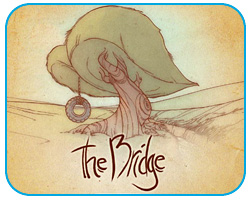 Next up in our series of games from the Spring 2009 semester is Next up in our series of games from the Spring 2009 semester is The Bridge, another arthouse game from Doris C. Rusch, the product owner of last summer's Akrasia. This game, a rumination on loss and mourning, is now available to play. You may want to check it out before reading the following reflection from Doris on the game's creation - there are spoilers ahead! - but definitely do come back and give the following essay a read, to share in Doris' experiences with game design as its own personally reflective, insightful process. -Geoff
The Bridge: Game Design as a Tool for Reflection and Self-Exploration
by Doris C. Rusch
The Bridge is a short, single player Flash game, made during the spring semester of 2009 by a team of students. I was the product owner and lead designer of this project. Although I have my doubts regarding The Bridge's qualities as a game (for which I take full responsibility), I still regard it as one of the most interesting works I've ever done. The focus, however, is on "work" as in "process", not the result. Working on The Bridge showed me what a wonderful tool for self-reflection and insight game design can be. The following is an account of how using the tools of my craft helped me and two of my team members to more clearly map out our emotional landscapes. Feel free to try this at home!
Guided by Images
Saying I wanted to make a game about "mourning" or the connection between "love" and "fear of loss" would be bullshitting (Def. bullshitting: terminus technicus for making a process appear intentional and focused in hindsight when it actually was not). So, let's just stick to the dirty truth of how it really went.
It started with an image of an empty tire swing that suddenly bubbled to the surface of my subconscious but never quite made it into the more analytical realm of my mind. The image didn't come with an explanation, only with an emotional overtone of loss, frustration and hoping against hope. A bit like a cone without ice cream, a tire-swing is a sad affair when it just hangs there without a child on it. Of course, one can take either image both ways: as a promise for future fun or as the memory of past pleasures. In the moment my mind decided to release the tire swing from its swampy depths, I gravitated towards the darker reading of it. But why a tire swing? Why not a more traditional metaphor for loss, such as a gravestone or a couple dressed in black, huddled together under an umbrella?
How I would love to be able to give a clever and coherent explanation now. But I vowed to adhere to honesty and will thus further refrain from bullshitting. The best I can do is share the stream of associations with you that (to me) accompanied the tire-swing metaphor.
Imagine being the one pushing the swing with the child on it. You push, you watch the swing perform the familiar motion, you wait for it to come back to you, and you push it again. The "here-gone" dichotomy strongly resonated with me. The necessity of letting go of the swing in order for it to fulfill its purpose (i.e. provide a pleasurable experience for the child) and at the same time distancing yourself from the precious freight it carries, experiencing a moment of anticipation (anxiety?) before the swing starts to come back, and the relief upon its safe return. But this relief is not really due to the return of the swing, but to the return of the child on it. In most cases, these two things are coupled. While the cycle of the swing will not be interrupted as long as one keeps pushing (what goes up must come down, right?), it is possible to lose a person forever. Fate is less predictable than physics. If the swing is "gone" it will transform into "here" again. A person, once dead, will remain gone. Child and swing - once fused together - are indeed separate entities; they can part ways. The stubborn mind, however, is reluctant to dissociate the two. The swing has always brought the child back, so maybe pushing an empty swing will magically return what has been lost. But some things cannot be changed, no matter how hard we push...
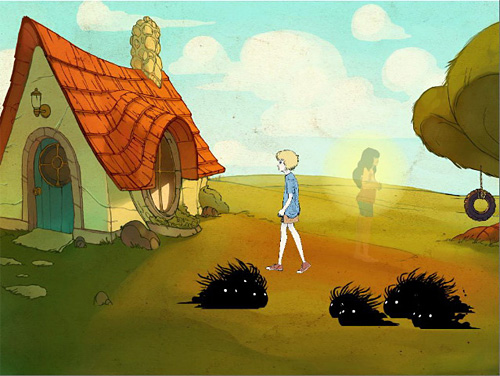 The Initial Idea
The interactive piece I initially envisioned (I wasn't even going to call it a game!) was strongly inspired by this crude image of an empty tire-swing and the foggy feelings of loss and mourning I associated with it. The player would enter an empty space with nothing but a swing in it and nothing to do but to push it. Pushing the swing would produce faint laughter and the transparent outline of a child would become visible on the swing. The implied goal would be to push until the child materialized completely. In truth, no such thing would be possible, though. The player would have to realize that all her efforts were for naught, that there was no way of bringing the child to life and that the only way to "win" was to accept that and walk away. In order to make this (emotionally) difficult for the player, every time she stopped pushing, the child would fade again, the laughing would grow faint at first, then maybe turn into whimpering (good audio would be required for this or instead of inducing guilt, the whining would create the wish to quickly leave the wretched child behind).
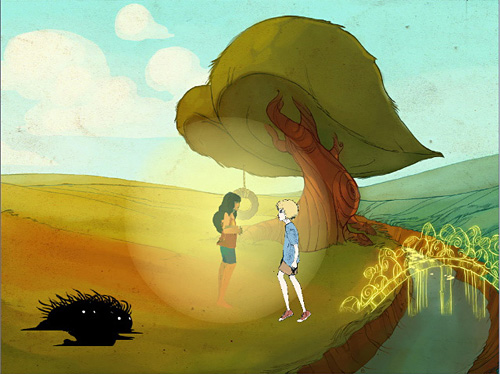 Using "The Tools" for Self-Exploration: A Conversation With The Inner Game Designer
When I talked to my friends Jaroslav and Eric about this initial idea - both very game savvy - they saw the potential for an emotionally compelling experience. However, they thought it should be more "gamey". I was reluctant at first. The simple tire-swing sequence felt so right that I wanted to do it exactly as I had described above. And then, they popped the Question (yep, it deserves the capital letter): "But what exactly is this about?" Mourning, clinging, loss, attachment - whatever I said to explain it didn't quite capture it. I couldn't put it in words. Since I'm strongly advocating purposeful design, not knowing my own mind was a problem. How can I purposefully create an experience for someone else if I don't understand my own feelings?
This had to change. I decided to follow my friends' advice and make it more "gamey". Because although the game itself can be ambiguous and allow multiple interpretations, coming up with the rules forces the designer to be precise and concrete. I started to explore what I already had in mind in terms of game elements. Here's a rough transcript of the dialogue I had with what I call my "Inner Game Designer" (IGD):
IGD: What exactly is the GOAL?
Me: To "let go".
IGD: A goal without CONFLICT makes for a lousy game. So what is the conflict? What makes "letting go" difficult?
Me: Attachment makes it difficult.
IGD: What creates attachment?
Me: Hm...love?
IGD: So, the way to overcome attachment is to overcome love?
Me: I don't think so. That would be terrible. Love is important.
IGD: Are you sure it is love, then, that bothers you? Maybe it's fear?
Me: Oh yeah? Well, what do YOU know?
IGD: I'm you, remember?
Me: Attachment and fear. Fear of losing love. You cling because you are afraid...
IGD: What exactly are you afraid of?
Me: Haven't I just said that? Afraid of losing love! Isn't that obvious?
IGD: Aren't you a bit negative?
Me: Don't play the Eliza trick on me!
IGD: All right, I'm sorry - couldn't resist. Seriously now, why would losing love be bad? It sounds like love serves a purpose.
Me: It protects...makes you feel good.
IGD: And since you don't want to lose what makes you feel good, love itself creates fear. It is both the curse and the cure, it seems.
Me: That's right. Fear creates clinging, you want to stay close to the "love object".
IGD: May I point out that you don't seem to have internalized love? It's this outside thing on which you depend. That attitude will always kick you in the butt.
Me: You're my inner game designer, not my freaking therapist.
IGD: Seems like pretty much the same thing to me...
I will spare you the rest of the conversation because it involved giant flying puddings and the monster with 14 toes, neither of which had any relevance to The Bridge. But you can see how the concept had dramatically evolved from the simple initial idea to a system that tackles the mechanisms of a certain kind of love and the problems that come with it. What was still lacking was an idea of how to overcome those problems, to get "unstuck" and break the pattern. Obviously, you had to fight your fears so you weren't dependent on your love object anymore and could love it in a more selfless way. And then what?
It was at the speakers' party at this year's Game Developer's Conference in San Francisco when Trey (the game's producer) and Jamie (code and animation) approached me with the words: "we have been thinking." Sitting in front of cocktails called "The Game Designer" or "Achievement Unlocked", they spoke to me of closeness, emancipation and sacrifice in a serious and insightful way. We pondered how the game could end. We knew the goal, we had grasped the conflict. Now we had entered the final stage of the process: finding a solution. What happened when you killed the monsters that represented your fears? What happened to the girl that represented your love object? What exactly would "letting go" look like? It was Jamie who dumped the solution in my lap: every monster you killed would help form a bridge across the river that divided the playground (the game's main space) from the untended field (representing an unknown future). I loved the symbolism that the road to a better future was paved by one's conquered fears. We further entertained the rather disturbing idea that the girl would sacrifice herself to complete the bridge, that her (self-inflicted) death would produce the last missing piece. We let this sink in. Nah...no good, since it would undermine the emancipation process which depends on taking responsibility for one's actions. So, maybe the player had to kill the girl before the bridge solidified? No, no, no! Not reconcilable with the idea of selfless love! We finally agreed that to win the game, one would have to kill all the monsters in the playground and refrain from "reclaiming" the girl on the tire-swing. The bridge would solidify upon the death of the last monster and one could cross it. Crossing the bridge would "free" the girl (she'd dissolve into a could of particles). This should not mean that one abandoned love itself, but had overcome functionalizing it.
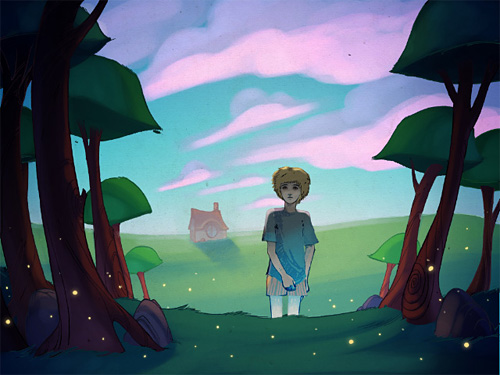 The True Reward Was The Journey
My team had an equivalent of two 40-hour work weeks to develop this game. This is not a lot of time, but they did an amazing job. Our biggest problem, however, was that the theme was so personal. If a project is too big, you can always scope it down. But if you are very invested in the concept you want to convey, to do it justice and get it right, the problem starts much sooner than scope. It starts with understanding what exactly you want to model.
We tried something big with The Bridge. Too big, maybe, for the given timeframe. I felt bad for a while after our last official work session, because how can you close the book on "love" and walk away feeling like you've accomplished anything? Also, eighty hours of development time do not leave a lot of room for tweaking and polishing and thus many of the ideas in the game are still latent and could be communicated to players more clearly.
But then again, I have learned a lot. The process of designing this game made many things apparent to me, helped me map out some of my emotional landscape. In that regard, The Bridge was a huge success. It confirmed my belief that while making profound games that tackle the human condition is a worthy goal which I will keep pursuing, game design itself can be a wonderful tool for insight that greatly enhances our understanding of ourselves. 
June 24, 2009
Announcing the Spring 2009 GAMBIT Games!
Keep an eye on the Load Game section of the GAMBIT website! Over the next couple of weeks, we're going to be launching the Spring 2009 lineup of GAMBIT games, including The Bridge, Moki Combat (v2.0), Rosemary, and the digital version of Tipping Point.
The first of these is Rosemary, which is an adventure game in the style of The Secret of Monkey Island that experiments with the idea of nostalgia as a game mechanic. Check it out now at http://gambit.mit.edu/loadgame/rosemary.php, then read game designer Clara Fernandez-Vara's postmortem of the game on the GAMBIT Updates blog!
In related news, we've also posted the bios for the Summer 2009 students – check them out now in the Credits section of the GAMBIT site!
June 4, 2009
GAMBIT on ThirtyOn10.
A few months ago, a group of Boston University students invited some members of our lab to appear in an episode of ThirtyOn10, "a weekly news program produced by the Broadcast Journalism Graduate Students of 2009". The episode, which focused on the video game industry and its impact upon Boston, featured not only GAMBIT people Philip Tan, Clara Fernández-Vara, Matthew Weise, Marleigh Norton, Shota Nakama and Jonathon Georgievski, but a ton of B-roll footage from the lab and an entire segment interviewing friend of the lab Darius Kazemi. All five parts of the episode have been uploaded to YouTube, and you can check them out below.
Nice work, folks, and thanks for including us in your project!
June 1, 2009
GAMBIT's Phorm at E3!
For those of you lucky to be running around at the Electronic Entertainment Expo in Los Angeles this week, keep an eye open for our summer 2008 prototype game Phorm, which is being featured in the IndieCade Independent Games Showcase! Posted below is the official press release from IndieCade.
IndieCade @ E3: An Indie Games Showcase
What is the IndieCade International Festival of Independent Games?
- IndieCade is the only stand-alone Independent Game Festival in the Nation. It is also the only event of its type open to the public. It is a completely international event.
- IndieCade holds an annual juried competition that culminates in its annual Festival.
The 2009 Festival will be held in Culver City, California, October 1- 4, 2009.
The festival will include an interactive exhibition of finalist games, premiere screenings, live gameplay, a conference, salons, workshops, artist talks, performances, and more.
The IndieCade 2009 Festival is programmed to serve the gamemaking community, the industry, consumers of independent media, digitally energized youth, and the general public. Culver City is located between Hollywood, Santa Monica, and Downtown Los Angeles.
What are the IndieCade Showcase Events?
- IndieCade holds multiple showcase events at larger venues throughout the year including its IndieCade Europe event. These are either individually juried or curated depending upon the requirements of the venue.
The 2009 series of showcase events include:
IndieCade@E3, June 2-4
IndieCade@SIGGRAPH Sandbox, August 3-7
IndieCade@OIAF Canada, October 14-18
IndieCade Europe @ GameCity, October 26-31
What is IndieCade's Mission?
- IndieCade supports independent game development and organizes a series of international festivals and showcase exhibitions for the future of independent games. It encourages, publicizes, and cultivates innovation and artistry in interactive media, helping to create a public perception of games as rich, diverse, artistic, and culturally significant. IndieCade's events and related production and publication programs are designed to bring visibility to and facilitate the production of new works within the emerging independent game movement. Like the independent developer community itself, IndieCade's focus is global; it includes producers in Asia, Europe, Australia, and wherever independent games are made and played. IndieCade was formed by Creative Media Collaborative, an alliance of industry producers and leaders founded in 2005. Advisors to IndieCade include Dave Perry, Will Wright, Eric Zimmerman, Neil Young, Tracy Fullerton, and Keita Takahashi, among many other storied industry veterans and rebels.
What do we mean by independent?
- Simply put, independent games are games that come from the heart, that follow a creative vision, rather than a marketing bottom line. Independent developers are not owned by or beholden to a large publisher. This means that they generally have smaller budgets than mainstream games (often no budget at all!), but they also have the freedom to innovate and to enlarge our conception of games and game audiences. Indie developers can run the gamut from artists, to academic researchers, to students, to emerging development studios striving to make the next big indie hit. They can be one person or a large team. They may be internally funded, funded by grants or private investors, or not funded at all! The key is that they create games based on their own unique vision.
What is IndieCade doing at E3?
- We were invited to curate this exhibition in order to showcase and promote innovation in the game industry. We also help to expose publishers to new independent voices. We work closely with the ESA, the IGDA and other organizations interested in supporting the cause of independent game creation. We share the goal of these organizations to showcase the present and future of video games as a culturally significant form of expression.
How were the games for the E3 Independent Games Showcase Selected?
- The showcase was curated by IndieCade co-chairs Celia Pearce and Sam Roberts and Creative Media Collaborative CEO Stephanie Barish. The games were primarily drawn from the 2009 Submissions to IndieCade and we included a few successful games from last year's selection that are otherwise not possible to see. The criteria for this showcase was to put together a diverse array of games that would showcase innovation for the mainstream game industry and game press, represent a wide array of independent game developers, and highlight works to come later this year.
Who are the developers?
- The developers represented here include individuals, small teams, independently owned studios, universities and their faculty and students. Developers come from around the world including the US, Belgium, Spain, Austria, Great Britain and others.
Are any of these games slated for mainstream publication?
- Last year a number of games shown by IndieCade were picked up by major publishers such as Nintendo, Xbox, and Sony, as well as multiple digital distribution platforms. Other games were selected for Museum installations and other artistic venues. So, don't be surprised to see some of the titles at our showcases and festival as commercial games in next year's E3.
IndieCade @ E3: An Indie Games Showcase
Hands-On Demos
And Yet It Moves*
And Yet It Moves Team
*(2007/2008 Official IndieCade Selection, Coming to Nintendo Wii Soon!)
Blueberry Garden*
Erik Svedäng/Sweden
*(2008 Official IndieCade Selection, 2009 IGF Awardee)
Closure
Tyler Glaiel & Jon Schubbe/United States
Cogs
Lazy 8 Studios/United States
Dear Esther
thechineseroom/United Kingdom
Flywrench* & Cowboyana
Messhof, Mark Essen/United States
*(2008 Official IndieCade Selection, Currently on display at New Museum, New York)
Global Conflicts: Latin America
Serious Games Initiative/Denmark
Octopounce
Auntie Pixelante/United States
Papermint
Avaloop/Austria
Snapshot
RetroAffect/United States
Winds of Orbis: An Active-Adventure
Deep End Interactive/United States
Zephyr: Tides of War
Florida Interactive Entertainment Academy/United States
Alternate Reality, Live Games, and Installations
The Deep Sleep Initiative
ARx/United States
Mightier
Lucas Pope & Keiko Ishizaka/United States
Pluff
Diana Hughes/United States
Prototype161: Agents Wanted
Prototype 161/United States
Mobile
AquariYum!
Teatime Games/United States
Bobobua
Tripod Games/China
Guru Meditation
Ian Bogost/United States
Ruben & Lullaby
Erik Loyer/United States
Games on Video
Fabulous/Fabuleux
Lynn Hughes & Heather Kelley/Canada
Gray
Mike Boxleiter & Greg Wohlwend/USA
Posemania
Anthony Whitehead, Hannah Johnston, Kaitlyn Fox, Nick Crampton, Joe Tuen/Canada
Phorm
Singapore-MIT GAMBIT Game Lab/United States & Singapore
When The Bomb Goes Off
Tom Sennett/United States
Art Exhibition
For this year's E3, IndieCade selected games from past years to present high-resolution prints of screenshots. Below is a list of art on display and the artwork being showcased.
Braid*
Jon Blow & David Helman/United States
*(2007 IndieCade Offiial Selection, Xbox Live Arcade)
Blueberry Garden*
Erik Svedang/Sweden
*(2008 IndieCade Official Selection, 2009 IGF Awardee)
The Endless Forest - ABIOGENESIS
Tale of Tales/Belgium
Freedom Fighter '56
Lauer Learning/United States
ioq3aPaint
Julian Oliver*/Spain
*(2008 IndieCade Awardee, Technical Innovation)
Machinarium*
Amanita Design/Czech Republic
(2008 IndieCade Awardee, Aesthetics, 2009 IGF Design Awardee)
The Misadventures of P.B. Winterbottom*
The Odd Gentlemen/United States
(2008 IndieCade Awardee, World/Story, Distribution to be announced Shortly)
The Night Journey*
Bill Viola Studio and USC/United States
*(2008 IndieCade Awardee, Sublime)
Nobi Nobi Boy Collage
Keita Takahashi*/Japan
*(IndieCade Board of Advisors)
Passage*
Jason Rohrer/United States
*(2008 IndieCade Awardee, Jury Selection)
Rooms*
Hand Made Games/Korea
*(2007 Official Selection, Available on Big Fish Games)
Ruckenblende*
Die Gute Fabrik (the good factory)/Denmark
*(2008 IndieCade Awardee, Gamemaker's Choice)
The Unfinished Swan
Ian Dallas/United States
Where is My Heart?
Bernhard Schulenburg/Germany
IndieCade Sponsors, Supporters, and Partners
The Culver Hotel
The City of Bellevue, Washington
The City of Redmond, Washington
Electronic Entertainment Design and Research (EEDAR)
The Entertainment Software Association (The ESA)
GameCity, Nottingham
Gregg Fleishmann Gallery
The International Game Developers Association (IDGA)
Gaming Angels
IDG World Expo
Imago imaging
Jon Burgerman
Open Satellite Gallery
M Café de Chaya
Mary Margaret Network
Royal-T
Rush Street
Signtist
SIGGRAPH
The Wonderful World of Animation Gallery 
April 22, 2009
This is GAMBIT on CNN
A few months ago, our lab opened its doors to Boston University journalism student Andrea Peterson, who was doing a piece on the process of making video games. Lo and behold, this morning we got an email from one of our alumni who had just spotted the resulting video on the Tech page of CNN.com!
Peterson's video was uploaded to iReport.com, the user-generated subsite from CNN, and has apparently been vetted for airing on CNN. The video features GAMBIT's Clara Fernández-Vara, Matthew Weise and Marleigh Norton speaking about a wide range of topics.
"What is it that we want to do? We have a world, what has happened in this world? And from that, what does the player have to do in order to discover that story?" notes Fernández-Vara. "The imagination has no limit. The limit that we have is time."
"I actually joke about how the game industry doesn't like to talk about the 'F' word, which is 'fun'," says Norton. "We all agree that everyone plays games for fun, but it's hard to quantify what that means."
(Note: if the video above isn't appearing, you can check it out on iReport.com or on YouTube.) 
April 7, 2009
A Chair for Dr. Juul
One of the greatest high points of an academic's career is when they are awarded a chair in recognition of their work. Today Ian Bogost brought it to our attention that our own Jesper Juul already has a chair – at IKEA.
As Ian notes in his blog:
On first blush it looks like those ill-fated ergonomic chairs of the 1980s, but it's really just a bench at two heights. The user is meant to straddle the lower height and use the upper to rest his arms while holding a videogame controller, avoiding the strenuous and annoying work of holding up his own arms.
Even more remarkable is the seat's name: Jesper. No matter the commonality of this forename, surely we can only conclude that this product represents the Swedish company's attempt to take advantage of fellow scandinavian and well-known games researcher Jesper Juul.
The difference between him and his namesake bench? Juul can hold his own arms up while playing videogames.
We're going to have to pick up a couple for the lab. One can never have too many Jespers, after all. Anyone interested in their very own signed Jesper (the bench, not the ludologist) can ping the good Dr. Juul via his blog or his website.
(Thanks to Clara Fernandez-Vara and Ian Bogost for the story and the image!) 
|
|



